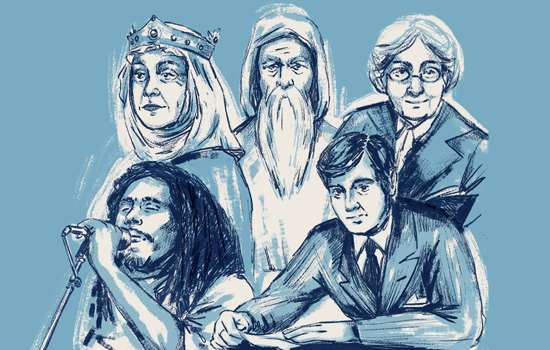SMOKE DRAWINGS, BERWICK-UPON-TWEED BARRACKS, NORTHUMBERLAND
Created by soldiers in the eighteenth century, the smoke drawings on the ceiling of the barracks are a fascinating insight into the everyday lives of the men living in the barracks. Discovered during conservation work in the 1970s and 80s, the drawings include horses, buildings, women and names, made using candle smoke and stencils. Some of the smoke drawings are on display in the exhibition area of the barracks, while the others in storage have recently been cleaned and stored in purpose-made boxes. This will allow for more research into the stories behind the pictures.
PLAN YOUR VISITCELL BLOCK GRAFFITI, RICHMOND CASTLE, YORKSHIRE
Under Richmond Castle lies a military cell block whose walls are covered in graffiti spanning several decades, including some by a group of WW1 conscientious objectors. From delicate portraits of loved ones to quotes, music and even a pattern for lace, the scratched and drawn graffiti tells the story of the men imprisoned in the castle. While the cells aren’t currently open to the public, you can view the graffiti in an online gallery and read more about the men behind the marks.
LEARN MOREPRISONER OF WAR GRAFFITI, PORCHESTER CASTLE, HAMPSHIRE
Portchester Castle on the south coast is also home to artwork drawn by prisoners of war, this time by French prisoners taken captive during the Napoleonic Wars of the 18th and early 19th century. Carved into the walls of the staircase between the third floor and the roof of the keep are words, dates and drawings of boats. You can also see wall paintings by the prisoners.
PLAN YOUR VISITMEDIEVAL WALL PAINTINGS, LONGTHORPE TOWER, CAMBRIDGESHIRE
Decorating the inside of a room in this 14th century tower is a series of extraordinary drawings depicting religious, mythical and secular subjects. Commissioned by the builder of the tower, the nobleman Robert Thorpe, the paintings’ subjects include kings, celestial bodies and beasts. The themes of the paintings contribute towards a narrative displaying the education and status of Robert Thorpe and his position in society. The paintings were drawn directly onto the dry limewashed plaster and would originally have been elaborately coloured and finished with gilt. They’re in a fragile state, but they’re currently undergoing detailed conservation work.
Plan your VisitFUNERARY SCULPTURES, DE GRAY MAUSOLEUM, BEDFORDSHIRE
The final resting place of the de Grey family of nearby Wrest Park, this mausoleum has an amazing collection of funerary sculptures and effigies. The building itself dates to the 17th century, was expanded in the 18th century and was considerably altered in the 19th century to accommodate Thomas de Grey and his family – the same Thomas who built the mansion at Wrest Park. As well as being an interesting record of the De Grey family, the monuments take you on a journey through different sculpture styles, from the painted and lying down effigies of the Jacobean era to the marble Victorian figures who take inspiration from classical Roman and Greek art.
PLAN YOUR VISITGRAFFITI AT STONEHENGE, WILTSHIRE
The enigmatic Stonehenge has long exerted a magnetic pull for those wishing to make their own mark on the prehistoric monument, and over the years many have carved their names onto the famous stones. On the face of stone 23 are the words ‘SEDGFIELD’ and ‘ANSTIE’, ‘IOH LVD DEFERRE’ is found on stone 53 and, going back even further in time, there are also drawings of an axehead and dagger on stone 53, which have been dated to between 1750 and 1600 BC. The most famous Stonehenge vandal may well be Christopher Wren – a carving on stone 52 of ‘I WREN’ has often been attributed to the architect, who grew up only 15 miles away in East Knoyle.
PLAN YOUR VISITTILED FLOOR, CLEEVE ABBEY, SOMERSET
The Refectory floor of this Somerset monastery was decorated with high-quality ceramic tiles showing a number of heraldic designs, including the coat of arms of King Henry III. There’s nothing else like this in the rest of the country, making it a hugely significant medieval work of art. The tiles were unearthed in 1876 but then reburied to protect them. They were uncovered again in 1951 and put on display during the summer, but an oak shelter built in 2016 now allows permanent access in a controlled environment to ensure the floor’s survival.
PLAN YOUR VISITWALL PAINTINGS, LULLINGSTONE ROMAN VILLA, KENT
The cellar of the villa was used a cult room for the veneration of a water deity or water nymphs, and a niche in the wall is decorated with a painting of three water nymphs. It was the painting’s position that saved it – the niche was later filled in with mortar and stone. Later Christian inhabitants added a small ‘house-church’ above the cult room, decorated with wall paintings. These include figures at prayer and a large Chi Rho – an early Christian symbol formed from Greek letters representing the word Christ, now on display in the British Museum. These are the only known paintings from Roman Britain that include explicit Christian symbolism.
PLAN YOUR VISITTROMPE L’OEIL PAINTINGS, ARCHER PAVILION, WREST PARK, BEDFORDSHIRE
The inside of the Archer Pavilion in the gardens of Wrest Park is decorated with a stunning series of trompe l’oeil paintings that mimic architectural features such as columns, niches and statues. Painted around 1712 by Mark Anthony Hauduroy, these ‘trick of the eye’ decorations convince you that they’re three dimensional. The pavilion was built by renowned architect Thomas Archer for Wrest Park owner Henry de Grey, the Duke of Kent. The elaborate paintings, which include the de Grey coat of arms, showcased the family’s rising status.
PLAN YOUR VISITWE NEED YOUR SUPPORT
We look after the largest collection of wall paintings in the country, and wall paintings like those at Longthorpe and Lullingstone need your support. Our conservation team visited sites with significant wall paintings to assess and prioritise those most in need of important conservation work. It was clear that many could be lost if we don’t address deterioration very quickly. So we need to bring together specialist conservators to accelerate our vital work.
Now we need your support to put specialists with these rare skills on site. With your help we can equip them with the latest technology and optimum materials so that we can save these treasures before it’s too late.
Find out more


